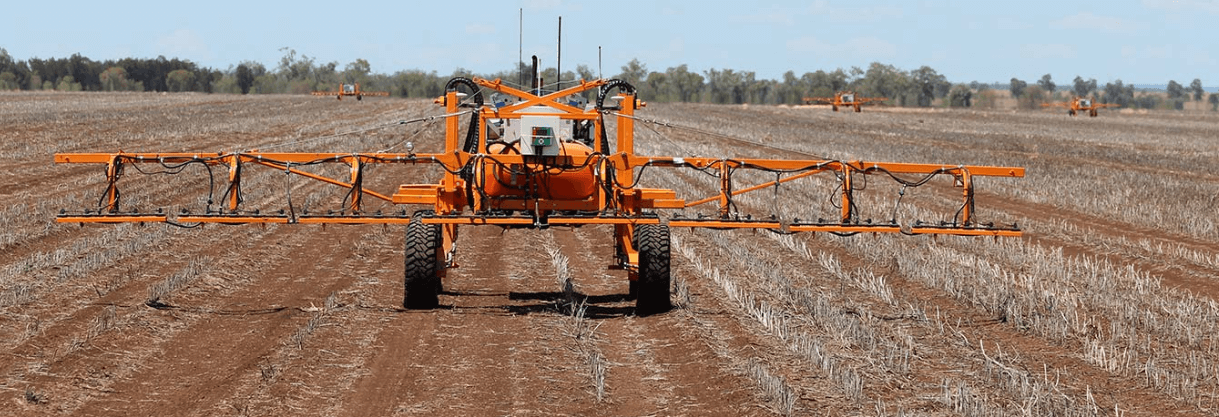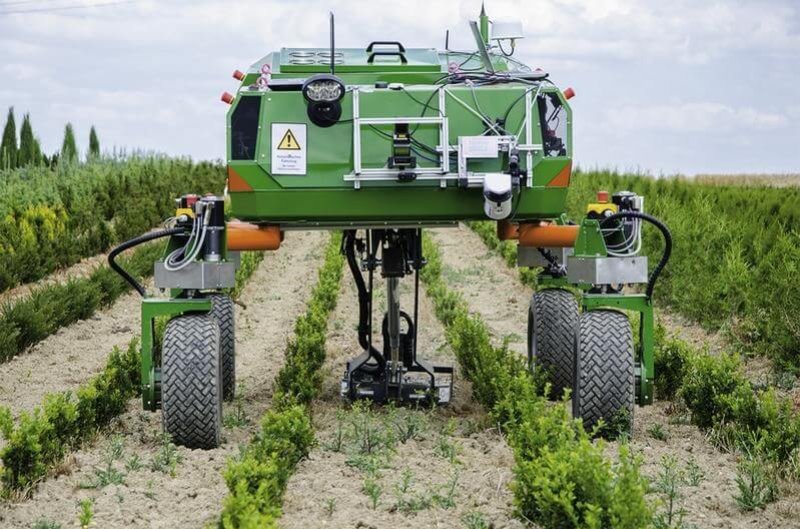There are a dizzying number of projects and companies seeking to apply robotics, computer vision and artificial intelligence (or machine learning) to the task of weed control. For some, the dream is to take herbicides completely out of the equation. For others, the goal is to dramatically reduce their use. Let’s take a look at some of the technical strategies being pursued, interrogating the pros, cons, trade-offs and likelihood of success.
Pure robotics
There have been attempts at pure mechanical control through robotics. This has the virtue of requiring no herbicides, and the nice clean environmental narrative that comes with that. There is a lot of upside, from a marketing perspective in being able to make the claim of controlling weeds without herbicides, but the technical challenges are daunting.
Bosch’s Bonirob weed control robot got a lot of hype back in 2015, and seems to have faded a bit in garnering attention. It is the size of a small car and kills weeds by punching them into the ground with a rod.
The other robot of note doing weed control mechanically is the Tertill, a garden weeder developed by the inventor of the Roomba. But a Roomba for your backyard garden isn’t going revolutionize agriculture as we know it any time soon.
https://www.youtube.com/watch?v=2Zbj3OnwyGQ
Autonomous sprayers
Despite early enthusiasm for herbicide-free weed control, most companies in this space have abandoned that as a goal, at least for now. The technical challenges of automating the last eighteen inches or so came to be seen as too daunting. The current focus is on using robotics, sensors and machine learning to do precision spraying, targeting unwanted plants rather than entire fields. Precision spraying allows the unit to move over the field more quickly than mechanical control and doesn’t require a bullseye every time in order to kill the weed. They may not eliminate herbicides but every company is claiming reductions in use of up to 90 percent. Herbicides would go from making up the majority of pesticide use to one among many and a smaller footprint for pesticides overall.
One strategy is to build dedicated, autonomous sprayers, leveraging what’s possible with robotics, GPS and AI. These are units that drive themselves through the field, hunting weeds. The great advantage here is that a single farmer can put their time to better use, being freed up from the cab. While automating a robotic interaction with each weed is difficult, these days programming a unit to self-navigate a field or low traffic country road crossings is a piece of cake.
Ecorobotics has a tiny, solar powered unit that seems appropriate for smaller, high value specialty crop farms around Watsonville and Salinas, CA. It’s not designed to cover the ground you’d need for Midwest row crops, but it has the advantages of being solar powered and its light weight will not cause compaction (pressing the topsoil into a tight, airless, brick-like condition that comes from having the tires of heavy machinery running repeatedly over the same ground. A serious issue for soil health on farms).
https://www.youtube.com/watch?v=IKZfjtPquzs
Australian-based SwarmFarms is building modular system of small self driving frame to which components can be added or subtracted. A precision sprayer is just one function that it can be assembled for. The company envisions farms owning small fleets of units that drive themselves and coordinate among themselves in the field. While not as lightweight as the Ecorobotics unit, the compaction is going to be considerably lower than a full tractor pulling a sprayer.

On the other hand, I think of owning four or five autonomous units and I think of owning four or five times as many moving parts and four or five times as many points of failure. This is mitigated by the fact that an equipment failure in one leaves three to four still operational. Depending on how easy they are to work on, how much firmware is walled off from user repair, these look like a cool system. Freeing up human labor for more valuable work than sitting in the cab is a big benefit.
Tractor pulled spray units
While they don’t leverage autonomous self-driving technology, tractor units appear to have the most sophisticated precision technology and have the virtue of leveraging a piece of capital investment most farms already own — a big expensive tractor that moves quickly through a field. And they can certainly be used with self driving tractors.
Blue River’s See & Spray system is an ink jet printer for field spraying, with the option to spray other products like fungicides or fertilizer. The system allows farmers to customize their strategy, tailoring how wide or narrow an area to spray or how aggressively they go after anything that looks like a weed. One key aspect of the technology is that it stores a record of the weeds it encounters and can give farmers data on weed density and variety, allowing them to fine tune their weed control regime.
Robotic weed control is very popular in Australia, and one farmer decided to make video demonstrating the speed and precision of his unit from WeedIt another Australian ag robotics company. To make this hit home for the average Joe or average Joey in the street, they programmed their field with weeds to coax the sprayer into performing Michael Jackson’s Beat It.
(While that’s fun, those bare fields are painful to behold.)
Could this technology help with resistant weeds?
This new technology would seem to have the potential to aid with managing herbicide resistant weeds. One could either apply more herbicide per weed, while lowering the amount per field or you might be able to use broad spectrum herbicides in settings where you currently can’t. To kick the tires of this idea, I spoke with three experts. But before we get to their insights, it’s worth understanding the genetics of weed resistance a little better.
When I spoke with Andrew Kniss at the University of Wyoming, I first wanted to make sure I understood the basic genetics of how weed resistance develops. This is the model I ran by him: “OK, you have a field with a million weeds and ten of them have traits that allow them to withstand exposure to an herbicide, but there is variation in how much of a dose they can survive, let’s say a scale of 1 to 10. If you we apply the herbicide at a rate of 7 on that scale of 1 to 10, we’ll kill seven of those weeds, but three will survive. The result is that their offspring will have that trait of tolerance, but with the variation around a higher set point. Seven becomes the new five.” He told me that was correct, but it was a description of a new form of resistance called creeping resistance, a problem that exacerbates when herbicide prices are high and farmers are tempted to apply at the lowest rate they think they can get by with. If farmers were able to apply higher doses per weed, while applying less to the field, they might kill potentially resistant weeds up to a higher threshold.
This is the form of resistance that the new precision tech might help in addressing. It wouldn’t make any difference with the older form of resistance. The other way that resistance develops is with a mutation that simply sidesteps the herbicide’s mode of action. That is, it renders the plant invisible to the herbicide, in the same way that the Roundup Ready trait renders Roundup Ready crops invisible to Roundup. If an herbicide binds to a certain receptor, the mutation just deletes that receptor.
While it’s plausible that these precision applications could be used to slow down the development of resistance or work around it, either through higher applications per weed or by allowing for more broad spectrum and different chemistries to be used on crops where they previously couldn’t be – because they would damage the crop – all three experts I talked to were dubious that this tech would play a major role in managing for resistance.
Adam Davis, department chair of crop sciences at the University of Illinois, pointed out that the technology might be useful if you were starting with a clean slate, but in Midwest row crops most weed populations already carry resistance traits for five to six modes of action already. It might be of more use in high value specialty crops where you have more of blank slate to start from.
The logistics of novel tank mixes isn’t so simple either. If the tech makes it possible to use an herbicide on a crop where it previously hadn’t been used, that requires regulatory approval, from the EPA and the relevant states.
Lynn Synososkie at UC Davis wondered what ways weed species and communities might start shifting in response to this new technology. Kniss noted that the technology is another step in making farming more capital intensive, which becomes another incentive towards farm consolidation and a headwind for smaller farms. Adam Davis said in his parting thoughts, “We can’t look for the answer to resistance in a jug, this technology may help on the margins, but the main strategy must continue to be confronting weeds with heterogeneity,diversification of crop rotations, of modes of action. We can’t maintain environments where weeds get too comfortable. They need to be challenged spatially, functionally, and temporally with diversity and heterogeneity.
Marc Brazeau is the GLP’s senior contributing writer focusing on agricultural biotechnology. He also is the editor of Food and Farm Discussion Lab. Follow him on Twitter @eatcookwrite































